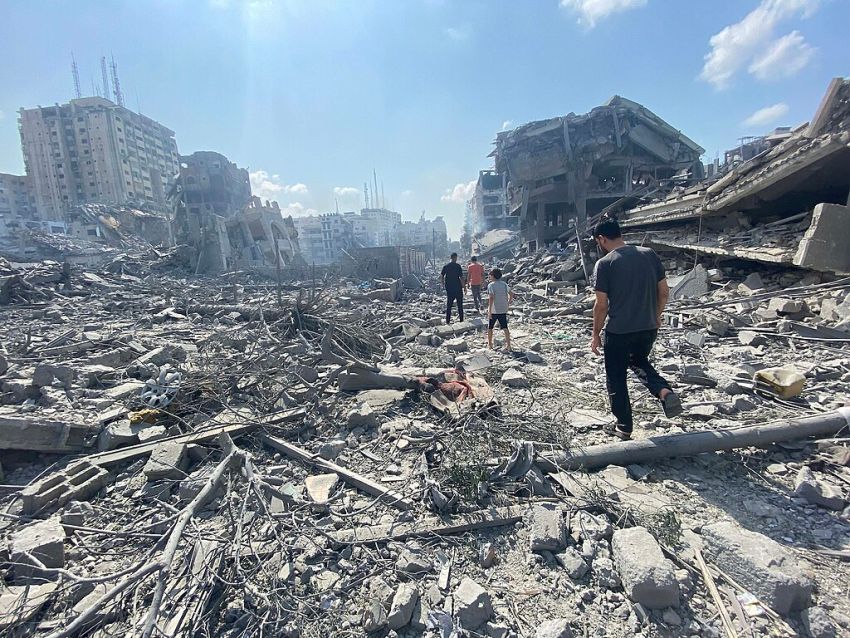
The world watches the destruction of Gaza as at least 15,500 Palestinians are killed including 6000 children. The world watches as Gazan hospitals are invaded, patients ordered to flee south where there is neither water, food nor safety.
The world watches while Israeli spokespersons claim they never target civilians and then comes the propagandist fig leaf to conceal all the cruelties. An Israeli spokesperson points to a hole in the ground beside a hospital as evidence of Hamas’ headquarters.
Locally, nationally, internationally, millions watch genocide in Gaza in disbelief. Millions join protests, sign petitions, pass motions pleading with indifferent Western governments, including Australia’s, to insist on a ceasefire to stop the killing and water, food and fuel to be sent to Gaza, and Israeli and Palestinian hostages rescued.
Millions ask why 75 years of Palestinian dispossession and experience of racist-fuelled violence has been allowed to climax in these mass murders in Gaza? Is the United Nations so impotent?
Something can be done.
A UN-sanctioned peace force could be sent into Israel, with its aim to cease the violence, hold Hamas and Israel accountable for war crimes and prepare the way for a durable peace settlement.
However idealistic the proposals to dispatch a peace force to Israel, the 2005 UN operational principle, “The Responsibility to Protect” which explains the moral and political justification for such intervention.
That principle reads as though the authors had the Israel war with Hamas in mind.
It says that states have a responsibility to protect populations from genocide, war crimes, ethnic cleansing and crimes against humanity.
If states do not protect their populations (or, in this case, the populations of lands they occupy) and, if assistance to do so is not effective, the international community has a responsibility to intervene and can do so under Chapters VI and VIII of the UN Charter.
Under those clauses, the UN “is prepared to take collective action in a timely and decisive manner through the Security Council, in cooperation with relevant regional organisations”.
Nevertheless, because the intervention clashes with the international norm of non-interference in states’ domestic affairs, the UN has a record of standing by and watching atrocities.
But there are precedents for UN intervention in response to murderous violence.
In Cambodia (1991) and in East Timor (1999), the UN authorised international peace forces, under the command of Australian generals John Sanderson in Cambodia and Peter Cosgrove in East Timor.
Amid this amoral killing spree in Gaza, glimmers of hope might be lit by recalling what happened in Cambodia and East Timor.
The UN General Assembly and the Security Council in the 1990s demanded France and Indonesia end violence in Cambodia and East Timor (respectively).
The Paris Peace Agreement was signed in October 1991 and under the command of Australian General John Sanderson, and with contributions from 46 nations, a 16,000-strong peace force was empowered by the UN Transitional Authority to promote national reconciliation and to conduct elections.
The Cambodian peace force experience teaches how to solve the peace settlement conundrums for Palestine and Israel.
The architects of intervention in Cambodia declared that violence would achieve nothing, that only a comprehensive political settlement could produce a just and durable peace, which would also contribute to regional and international and security.
The UN initiative in East Timor was another response to violence and agitation by powerful nations — mostly the US under President Bill Clinton. Peace force intervention occurred at different stages and with changing objectives.
A UN Assistance Mission was authorised to offer the East Timorese a choice between autonomy under Indonesia or independence.
Subsequently, following horrific militia violence in reaction to the people choosing independence, 1400 civilians died and 500,000 people were displaced. Global protests erupted, at which point, in September 1999, the UN Security Council passed Resolution 1264 which led to the multi-national force (INTERFET) of 8950 troops, headed by Australian General Cosgrove.
A UN Transitional Authority (UNTAET) later assumed responsibility to foster civil rights.
To repeat the UN’s Cambodian and East Timor interventions for peace requires a couple of bold, principled nations to remind the UN that they should squabble no longer as to whether a genocide can be halted, or whether too many Gazans have been killed.
A UN Charter and the precedent of Security Council resolutions are waiting to be imitated.
Meanwhile, journalists and politicians can empower themselves by referring to the “Responsibility to Protect” instead of staying silent when Israeli spokesperson Mark Regev repeats his claim that Israeli forces do not harm civilians and journalists.
The Responsibility to Protect could authorise a peace force be sent to Gaza. It may offend the US and Israel, but international law and UN resolutions have universal application: they are not a pick-and-choose means of deciding that powerful nations can be judged exceptional and their brutalities ignored.
[Stuart Rees AM is Professor Emeritus at the University of Sydney and a recipient of the Jerusalem (Al Quds) Peace Prize. A version of this article was first published Pearls and Irritations.]